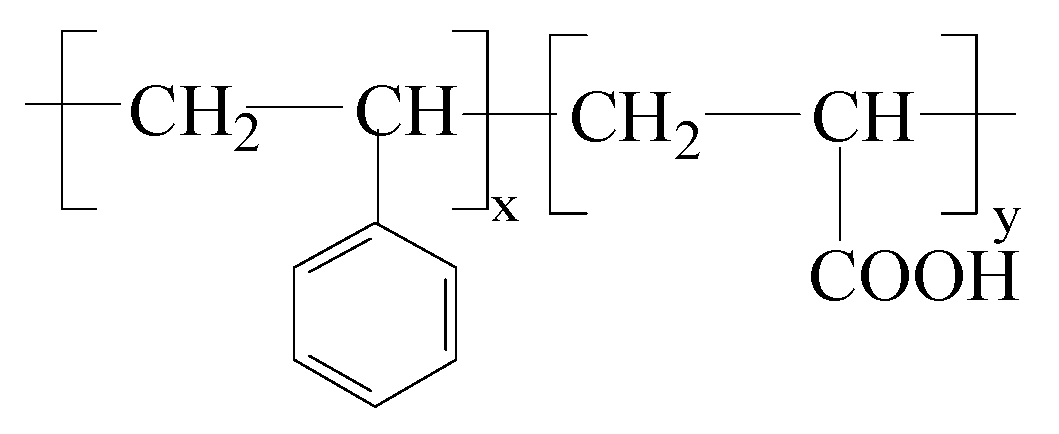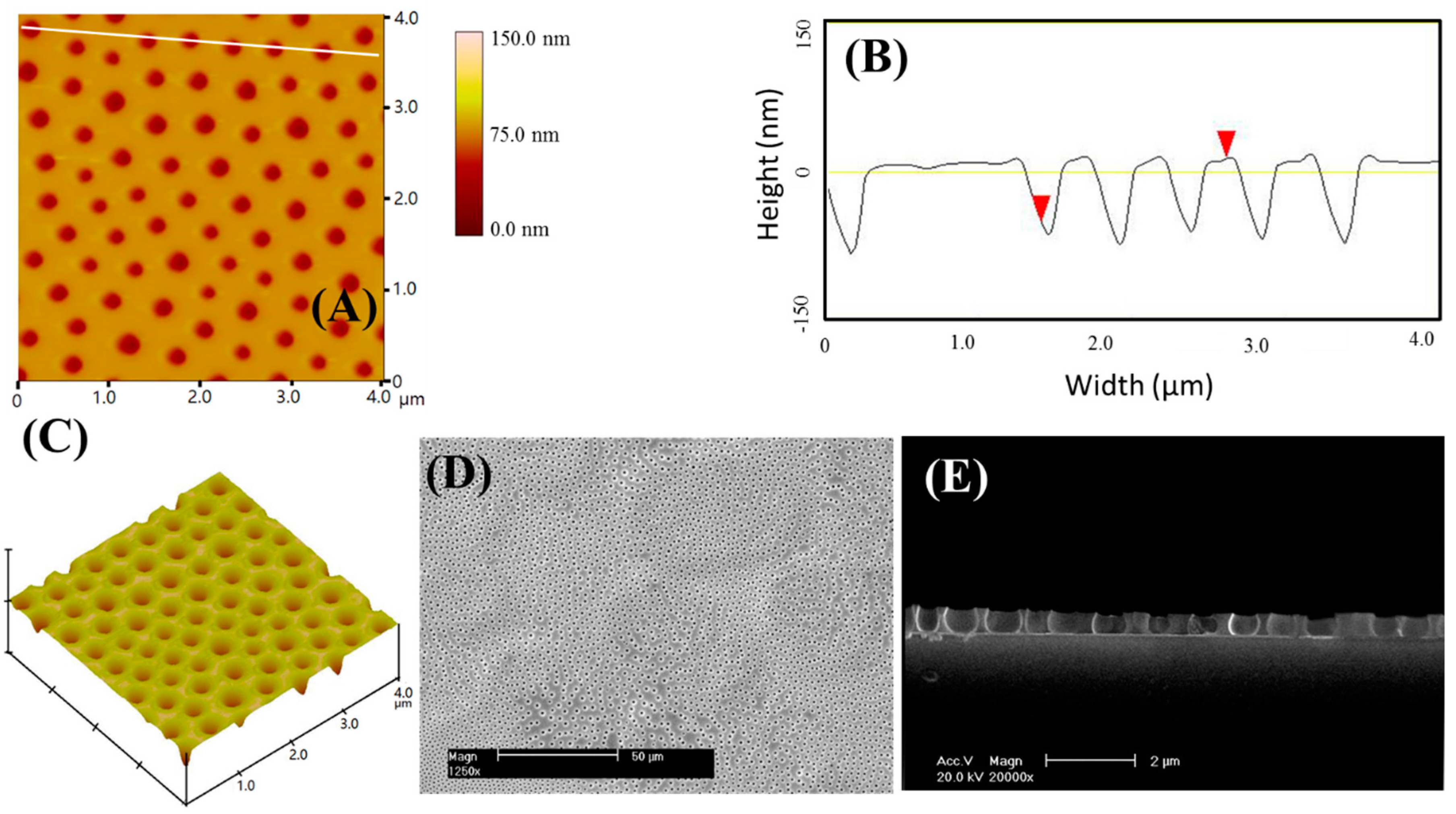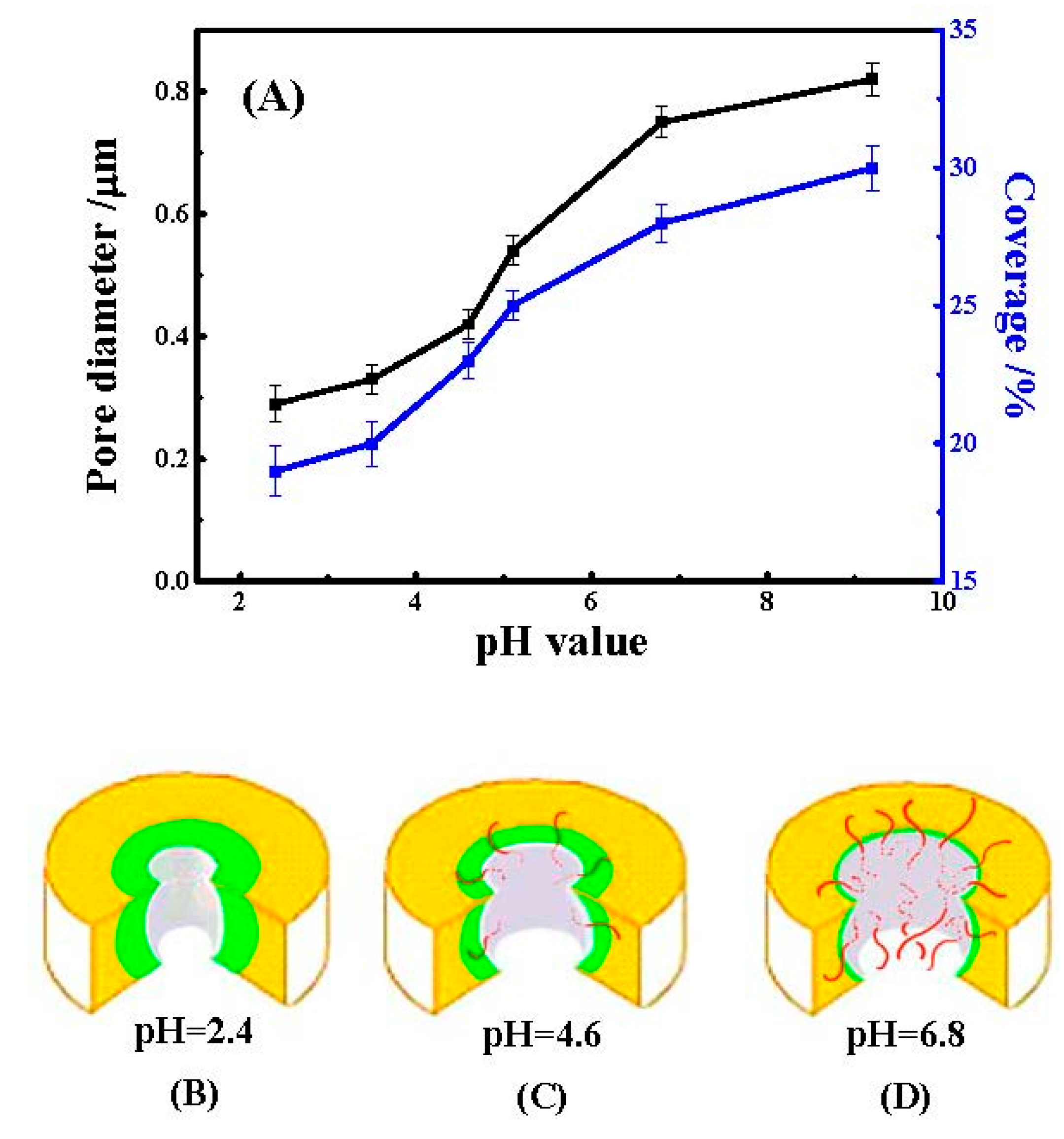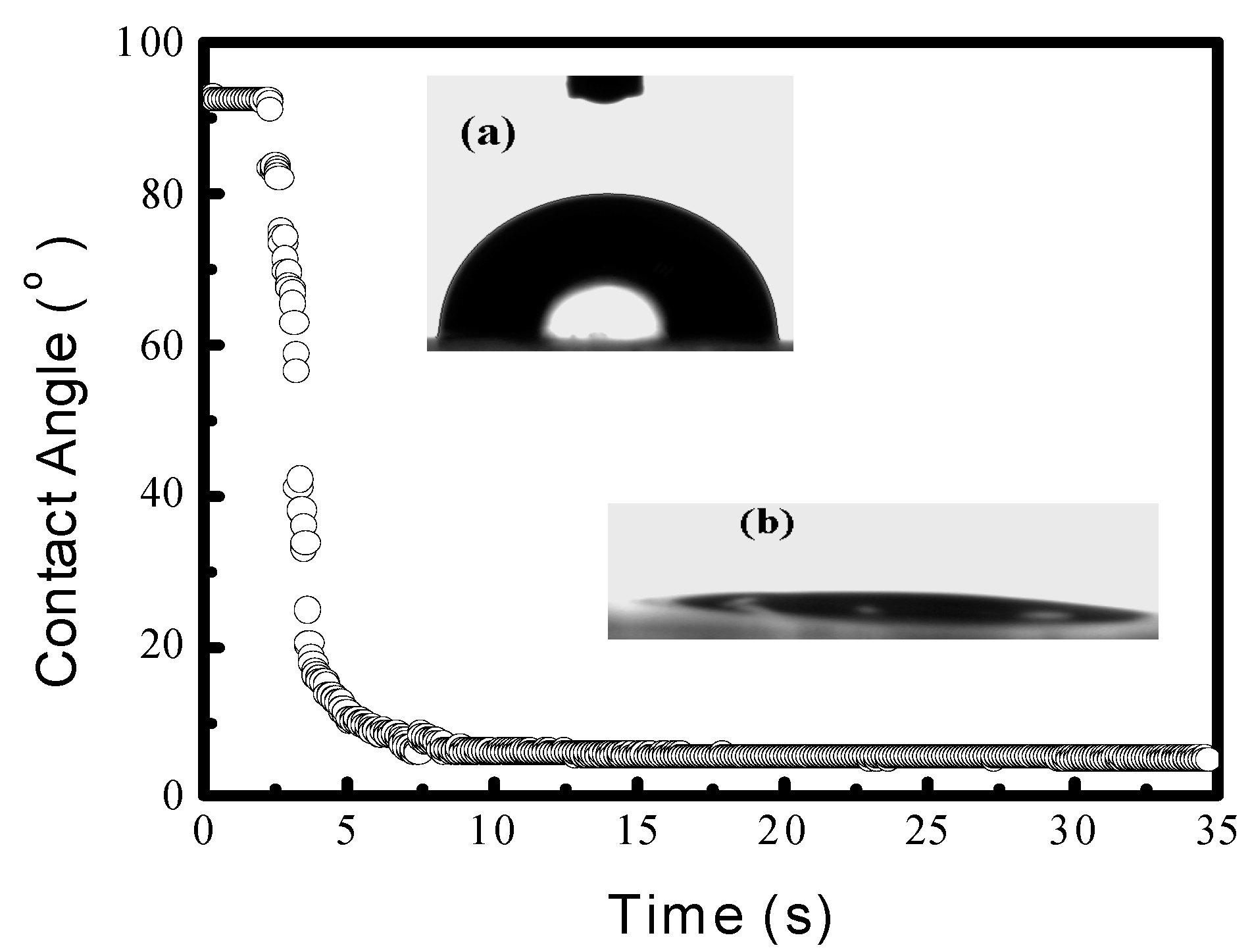Reversible pH Stimulus-Response Material Based on Amphiphilic Block Polymer Self-Assembly and Its Electrochemical Application
Abstract
:1. Introduction
2. Experimental Section
2.1. Materials
2.2. Apparatus
3. Results and Discussion
3.1. Fabrication of Microporous Solid Thin Films
3.2. pH Responses of PS–b–PAA Microporous Films with Their Tunable Surface Properties
3.3. PS–b–PAA Microporous Solid Thin Film Stimulus-Responsive Dynamics
3.4. The pH Effect on Electrochemical Responses of the Microporous Solid Thin Film
4. Conclusions
Acknowledgments
Author Contributions
Conflicts of Interest
References
- Xu, C.; Fu, X.F.; Fryd, M.; Xu, S.; Wayland, B.B.; Winey, K.I.; Composto, R.J. Reversible stimuli-responsive nanostructures assembled from amphiphilic block copolymers. Nano Lett. 2006, 6, 282–287. [Google Scholar] [CrossRef] [PubMed]
- Stuart, M.; Huck, W.; Genzer, J.; Mulier, M.; Ober, C.; Stamm, M.; Sukhorukov, G.B.; Szleifer, I.; Tsukruk, V.V.; Urban, M.; et al. Emerging applications of stimuli-responsive polymer materials. Nat. Mater. 2010, 9, 101–113. [Google Scholar] [CrossRef] [PubMed]
- Shaikh, R.P.; Pillay, V.; Choonara, Y.E.; du Toit, L.C.; Ndesendo, V.M.K.; Bawa, P.; Cooppan, S. A review of multi-responsive membranous systems for rate-modulated drug delivery. AAPS Pharm. Sci. Tech. 2010, 11, 441–459. [Google Scholar] [CrossRef] [PubMed]
- Yu, K.; Han, Y.C. Effect of block sequence and block length on the stimuli-responsive behavior of polyampholyte brushes: Hydrogen bonding and electrostatic interaction as the driving force for surface rearrangement. Soft Matter 2009, 5, 759–768. [Google Scholar] [CrossRef]
- Meng, H.; Li, G.Q. A review of stimuli-responsive shape memory polymer composites. Polymer 2013, 54, 2199–2221. [Google Scholar] [CrossRef]
- Wanasekara, N.D.; Korley, L.T.J. Toward tunable and adaptable polymer nanocomposites. J. Polym. Sci. Part B: Polym. Phys. 2013, 51, 463–467. [Google Scholar] [CrossRef]
- Liu, C.L.; Lin, C.H.; Kuo, C.C.; Lin, S.T.; Chen, W.C. Conjugated rod-coil block copolymers: Synthesis, morphology, photophysical properties, and stimuli-responsive applications. Prog. Polym. Sci. 2011, 36, 603–637. [Google Scholar] [CrossRef]
- Lee, Y.C.; Sun, Y.S.; Liou, J.Y.; Chuang, W.T. Hierarchically-responded assembly of block copolymer thin films with stimuli of varied solvent selectivity. Polymer 2012, 53, 5972–5981. [Google Scholar] [CrossRef]
- Sun, L.; Huang, W.M.; Ding, Z.; Zhao, Y.; Wang, C.C.; Purnawali, H.; Tang, C. Stimulus-responsive shape memory materials: A review. Mater. Des. 2012, 33, 577–640. [Google Scholar] [CrossRef]
- Chen, Y.C.; Xie, R.; Chu, L.Y. Stimuli-responsive gating membranes responding to temperature, pH, salt concentration and anion species. J. Membr. Sci. 2013, 442, 206–215. [Google Scholar] [CrossRef]
- Cabane, E.; Zhang, X.Y.; Langowska, K.; Palivan, C.G.; Meier, W. Stimuli-responsive polymers and their applications in nanomedicine. Biointerphases 2012, 7, 9–35. [Google Scholar] [CrossRef] [PubMed]
- Tokarev, I.; Minko, S. Tunable plasmonic nanostructures from noble metal nanoparticles and stimuli-responsive polymers. Soft Matter 2012, 8, 5980–5987. [Google Scholar] [CrossRef]
- Ravichandran, R.; Sundarrajan, S.; Venugopa, J.R.; Mukherjee, S.; Ramakrishna, S. Advances in polymeric systems for tissue engineering and biomedical applications. Macromol. Biosci. 2012, 12, 286–311. [Google Scholar] [CrossRef] [PubMed]
- Chen, T.; Amin, I.; Jordan, R. Patterned polymer brushes. Chem. Soc. Rev. 2012, 41, 3280–3296. [Google Scholar] [CrossRef] [PubMed]
- Liu, F.; Urban, M.W. Recent advances and challenges in designing stimuli-responsive polymers. Prog. Polym. Sci. 2010, 35, 3–23. [Google Scholar] [CrossRef]
- Yeo, S.J.; Kang, H.; Kim, Y.H.; Han, S.; Yoo, P.J. Layer-by-layer assembly of polyelectrolyte multilayers in three-dimensional inverse opal structured templates. ACS Appl. Mater. Interfaces 2012, 4, 2107–2115. [Google Scholar] [CrossRef] [PubMed]
- Schaaf, P.; Voegel, J.C.; Jierry, L.; Boulmedais, F. Spray-assisted polyelectrolyte multilayer buildup: From step-by-step to single-step polyelectrolyte film constructions. Adv. Mater. 2012, 24, 1001–1016. [Google Scholar] [CrossRef] [PubMed]
- Ludwigs, S.; Schmidt, K.; Krausch, G. One-dimensional swelling of a pH-dependent nanostructure based on ABC triblock terpolymers. Macromolecules 2005, 38, 2376–2382. [Google Scholar] [CrossRef]
- Park, J.H.; Schwartz, Z.; Navarrete, R.O.; Boyan, B.D.; Tannenbaum, R. Enhancement of surface wettability via the modification of microtextured titanium implant surfaces with polyelectrolytes. Langmuir 2011, 27, 5976–5985. [Google Scholar] [CrossRef] [PubMed]
- Gensel, J.; Dewald, I.; Erath, J.; Betthausen, E.; Müller, A.H.E.; Fery, A. Reversible swelling transitions in stimuli-responsive layer-by-layer films containing block copolymer micelles. Chem. Sci. 2013, 4, 325–334. [Google Scholar] [CrossRef]
- Lupitskyy, R.; Roiter, Y.; Tsitsilianis, C.; Minko, S. From smart polymer molecules to responsive nanostructured surfaces. Langmuir 2005, 21, 8591–8593. [Google Scholar] [CrossRef] [PubMed]
- Minko, S.; Muller, M.; Motornov, M.; Nitschke, M.; Grundke, K.; Stamm, M. Two-level structured self-adaptive surfaces with reversibly tunable properties. J. Am. Chem. Soc. 2003, 125, 3896–3900. [Google Scholar] [CrossRef] [PubMed]
- Kirchhof, K.; Andar, A.; Yin, H.B.; Gadegaard, N.; Riehle, M.O.; Groth, T. Polyelectrolyte multilayers generated in a microfluidic device with pH gradients direct adhesion and movement of cells. Lab Chip 2011, 11, 3326–3335. [Google Scholar] [CrossRef] [PubMed]
- Hong, J.; Kim, B.S.; Char, K.; Hammond, P.T. Inherent charge-shifting polyelectrolyte multilayer blends: A facile route for tunable protein release from surfaces. Biomacromolecules 2011, 12, 2975–2981. [Google Scholar] [CrossRef] [PubMed]
- Alonso, T.; Irigoyen, J.; Iturri, J.J.; Larena, I.L.; Moya, S.E. Study of the multilayer assembly and complex formation of poly(diallyldimethylammonium chloride) (PDADMAC) and poly(acrylic acid) (PAA) as a function of pH. Soft Matter 2013, 9, 1920–1928. [Google Scholar] [CrossRef]
- Karanikolas, A.; Tsolakis, P.; Bokias, G.; Tsitsilianis, C. Stimuli-responsive poly(ethylene oxide)-b-poly(2-vinylpyridine)-b-poly(ethylene oxide) triblock copolymers and complexation with poly(acrylic acid) at low pH. Eur. Phys. J. E 2008, 27, 335–343. [Google Scholar] [CrossRef]
- Connal, L.A.; Li, Q.; Quinn, J.F.; Tjipto, E.; Caruso, F.; Qiao, G.G. pH-responsive poly(acrylic acid) core cross-linked star polymers: Morphology transitions in solution and multilayer thin films. Macromolecules 2008, 41, 2620–2626. [Google Scholar] [CrossRef]
- Gao, X.Y.; He, C.L.; Xiao, C.S.; Zhuang, X.L.; Chen, X.S. Synthesis and characterization of biodegradable pH-sensitive poly(acrylic acid) hydrogels crosslinked by 2-hydroxyethyl methacrylate modified poly(l-glutamic acid). Mater. Lett. 2012, 77, 74–77. [Google Scholar] [CrossRef]
- Orlov, M.; Tokarev, I.; Scholl, A.; Doran, A.; Minko, S. pH-Responsive thin film membranes from poly(2-vinylpyridine): Water vapor-induced formation of a microporous structure. Macromolecules 2007, 40, 2086–2091. [Google Scholar] [CrossRef]
- Ansari, S.A.; Husain, Q. Potential applications of enzymes immobilized on/in nano materials: A review. Biotechnol. Adv. 2012, 30, 512–523. [Google Scholar] [CrossRef] [PubMed]
- Trillo, F.F.; Hest, J.C.M.; Thies, J.C.; Michon, T.; Weberskirch, R.; Cameron, N.R. Reversible immobilization onto PEG-based emulsion-templated porous polymers by co-assembly of stimuli responsive polymers. Adv. Mater. 2009, 21, 55–59. [Google Scholar] [CrossRef]
- Widawski, G.; Rawiso, B.; Francois, B. Self-organized honeycomb morphology of star-polymer polystyrene films. Nature 1994, 369, 387–389. [Google Scholar] [CrossRef]
- Escale, P.; Rubatat, L.; Billon, L.; Save, M. Recent advances in honeycomb-structured porous polymer films prepared via breath figures. Eur. Polym. J. 2012, 48, 1001–1025. [Google Scholar] [CrossRef]
- Maniglio, D.; Ding, Y.; Wang, L.; Migliaresi, C. One-step process to create porous structures in cross-linked polymer films via breath-figure formations during in situ cross-linking reactions. Polymer 2011, 52, 5102–5106. [Google Scholar] [CrossRef]
- Wang, L.; Maruf, S.H.; Maniglio, D.; Ding, Y. Fabrication and characterizations of crosslinked porous polymer films with varying chemical compositions. Polymer 2012, 53, 3749–3755. [Google Scholar] [CrossRef]
- Bunz, U.H.F. Breath figures as a dynamic templating method for polymers and nanomaterials. Adv. Mater. 2006, 18, 973–989. [Google Scholar] [CrossRef]
- Wan, L.S.; Zhu, L.W.; Ou, Y.; Xu, Z.K. Multiple interfaces in self-assembled breath figures. Chem. Commun. 2014, 50, 4024–4039. [Google Scholar] [CrossRef] [PubMed]
- Zhang, A.; Bai, H.; Li, L. Breath figure: A nature-inspired preparation method for ordered porous films. Chem. Rev. 2015, 115, 9801–9868. [Google Scholar] [CrossRef] [PubMed]
- Srinivasarao, M.; Collings, D.; Philips, A.; Patel, S. Three-Dimensionally Ordered array of air bubbles in a polymer film. Science 2001, 292, 79–82. [Google Scholar] [CrossRef] [PubMed]
- Lee, H.I.; Boyce, J.R.; Nese, A.; Sheiko, S.S.; Matyjaszewski, K. pH-induced conformational changes of loosely grafted molecular brushes containing poly (acrylic acid) side chains. Polymer 2008, 49, 5490–5496. [Google Scholar] [CrossRef]
- Escale, P.; Rubatat, L.; Derail, C.; Save, M.; Billon, L. pH Sensitive Hierarchically Self-Organized Bioinspired Films. Macromol. Rapid Commun. 2011, 32, 1072–1076. [Google Scholar] [CrossRef] [PubMed]
- Wang, C.Y.; Mao, Y.D.; Wang, D.Y.; Qu, Q.S.; Yang, G.Y.; Hu, X.Y. Fabrication of highly ordered microporous thin films by PS–b–PAA self-assembly and investigation of their tunable surface properties. J. Mater. Chem. 2008, 18, 683–690. [Google Scholar] [CrossRef]
- Wang, C.Y.; Shao, X.Q.; Liu, Q.X.; Mao, Y.D.; Yang, G.J.; Xue, H.G.; Hu, X.Y. One step fabrication and characterization of platinum nanopore electrode ensembles formed via amphiphilic block copolymer self-assembly. Electrochim. Acta 2006, 52, 704–709. [Google Scholar] [CrossRef]
- Wang, C.Y.; Liu, Q.X.; Shao, X.Q.; Yang, G.J.; Xue, H.G.; Hu, X.Y. One step fabrication of nanoelectrode ensembles formed via amphiphilic block copolymers self-assembly and selective voltammetric detection of uric acid in the presence of high ascorbic acid content. Talanta 2007, 71, 178–185. [Google Scholar] [CrossRef] [PubMed]
- Wang, C.Y.; Wang, D.Y.; Mao, Y.D.; Hu, X.Y. Research progress in ordered microporous thin films by self-assembly. Prog. Chem. 2008, 20, 105–116. [Google Scholar]
- Zhang, L.F.; Eisenberg, A. Multiple morphologies and characteristics of “crew-cut” micelle-like aggregates of polystyrene-b-poly (acrylic acid) diblock copolymers in aqueous solutions. J. Am. Chem. Soc. 1996, 118, 3168–3181. [Google Scholar] [CrossRef]
- Xu, C.; Wayland, B.B.; Fryd, M.; Winey, K.I.; Composto, R.J. pH-responsive nanostructures assembled from amphiphilic block copolymers. Macromolecules 2006, 39, 6063–6070. [Google Scholar] [CrossRef]
- Laforgue, A.; Bazuin, C.G.; Prudhomme, R.E. A study of the supramolecular approach in controlling diblock copolymer nanopatterning and nanoporosity on surfaces. Macromolecules 2006, 39, 6473–6482. [Google Scholar] [CrossRef]
- Tanchak, M.; Barrett, C.J. Swelling dynamics of multilayer films of weak polyelectrolytes. Chem. Mater. 2004, 16, 2734–2739. [Google Scholar] [CrossRef]
- Wang, C.Y.; Wang, D.Y.; Hu, X.Y.; Wang, G.X. Interface interaction within nanopores in thin films of an amphiphilic block copolymer and CTAB. J. Colloid Interface Sci. 2011, 354, 219–225. [Google Scholar] [CrossRef] [PubMed]






| pH Value of the Buffer Solution | 2.4 | 3.5 | 4.6 | 5.1 | 6.8 | 9.2 |
| Time for the Formation of the Pore in Stable Size (s) | 1125 | 1150 | 1200 | 1550 | 1750 | 1980 |
| Name | Meaning of Variable |
|---|---|
| Dt | pore size at time t |
| D0 | pore size in the dry state before react with water |
| D∞ | pore size at infinitely-great time |
| k1 | a characteristic constant that depends on the local environment of the penetrant |
| t | the reaction time |
| n | scaling exponent that describes the type of diffusion into the polymer |
| B | a scaling constant |
| k2 | the relaxation constant |
© 2016 by the authors; licensee MDPI, Basel, Switzerland. This article is an open access article distributed under the terms and conditions of the Creative Commons Attribution (CC-BY) license (http://creativecommons.org/licenses/by/4.0/).
Share and Cite
Wang, T.; Zhu, H.; Xue, H. Reversible pH Stimulus-Response Material Based on Amphiphilic Block Polymer Self-Assembly and Its Electrochemical Application. Materials 2016, 9, 478. https://doi.org/10.3390/ma9060478
Wang T, Zhu H, Xue H. Reversible pH Stimulus-Response Material Based on Amphiphilic Block Polymer Self-Assembly and Its Electrochemical Application. Materials. 2016; 9(6):478. https://doi.org/10.3390/ma9060478
Chicago/Turabian StyleWang, Tianyi, Hongmei Zhu, and Huaiguo Xue. 2016. "Reversible pH Stimulus-Response Material Based on Amphiphilic Block Polymer Self-Assembly and Its Electrochemical Application" Materials 9, no. 6: 478. https://doi.org/10.3390/ma9060478
APA StyleWang, T., Zhu, H., & Xue, H. (2016). Reversible pH Stimulus-Response Material Based on Amphiphilic Block Polymer Self-Assembly and Its Electrochemical Application. Materials, 9(6), 478. https://doi.org/10.3390/ma9060478






